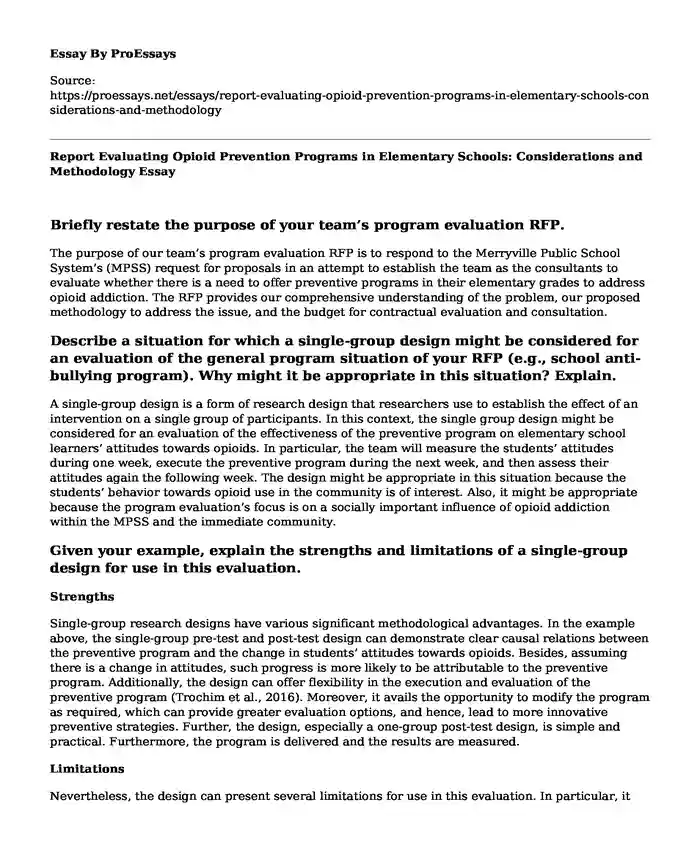Briefly restate the purpose of your team’s program evaluation RFP.
The purpose of our team’s program evaluation RFP is to respond to the Merryville Public School System’s (MPSS) request for proposals in an attempt to establish the team as the consultants to evaluate whether there is a need to offer preventive programs in their elementary grades to address opioid addiction. The RFP provides our comprehensive understanding of the problem, our proposed methodology to address the issue, and the budget for contractual evaluation and consultation.
Describe a situation for which a single-group design might be considered for an evaluation of the general program situation of your RFP (e.g., school anti-bullying program). Why might it be appropriate in this situation? Explain.
A single-group design is a form of research design that researchers use to establish the effect of an intervention on a single group of participants. In this context, the single group design might be considered for an evaluation of the effectiveness of the preventive program on elementary school learners’ attitudes towards opioids. In particular, the team will measure the students’ attitudes during one week, execute the preventive program during the next week, and then assess their attitudes again the following week. The design might be appropriate in this situation because the students’ behavior towards opioid use in the community is of interest. Also, it might be appropriate because the program evaluation’s focus is on a socially important influence of opioid addiction within the MPSS and the immediate community.
Given your example, explain the strengths and limitations of a single-group design for use in this evaluation.
Strengths
Single-group research designs have various significant methodological advantages. In the example above, the single-group pre-test and post-test design can demonstrate clear causal relations between the preventive program and the change in students’ attitudes towards opioids. Besides, assuming there is a change in attitudes, such progress is more likely to be attributable to the preventive program. Additionally, the design can offer flexibility in the execution and evaluation of the preventive program (Trochim et al., 2016). Moreover, it avails the opportunity to modify the program as required, which can provide greater evaluation options, and hence, lead to more innovative preventive strategies. Further, the design, especially a one-group post-test design, is simple and practical. Furthermore, the program is delivered and the results are measured.
Limitations
Nevertheless, the design can present several limitations for use in this evaluation. In particular, it presents an array of concerns about the validity of the findings and the measurement instrument, and consequently, the inability to measure the effectiveness of the preventive program with a high degree of confidence (Trochim et al., 2016). For instance, the one-group post-test design lacks a point of comparison, which underscores the modesty of the results. Similarly, planning and implementing a single-group pretest-posttest design can be time-consuming and it introduces the complexity associated with developing valid and useful tests to be administered before and after the implementation.
Would you choose a posttest only or a pretest-posttest design? Why?
I would choose the single-group pretest-posttest design because it can show a comparison between the group’s state before and after the preventive program. That is, if the attitudes towards opioid use are more negative after the preventive program than before, then the evaluators can conclude that the program might be, at least in part, responsible for the change. According to Trochim et al. (2016), to the extent that the design is administered to randomly selected participants repeatedly, this confidence in the effect of the program would grow.
How would you try to deal with threats to internal validity as part of your planning?
Certainly, the limitations of the single-group design are related to various threats to internal validity such as historical considerations, maturation, testing, and instrumentation aspects. I would try to deal with these threats by incorporating a control group that is comparable to the program’s group. I would randomly assign students to the two groups to ensure they are truly comparable.
Reference
Trochim, W. M. K., Donnelly, J. P., & Arora, K. (2016). Research methods: The essential knowledge base. Cengage Learning.
Cite this page
Report Evaluating Opioid Prevention Programs in Elementary Schools: Considerations and Methodology. (2024, Jan 10). Retrieved from https://proessays.net/essays/report-evaluating-opioid-prevention-programs-in-elementary-schools-considerations-and-methodology
If you are the original author of this essay and no longer wish to have it published on the ProEssays website, please click below to request its removal:
- Education Essay Example: Introduction and Description of the Report
- Analysis of MDGs and SDGs in Kenya and Bangladesh Paper Example
- Essay Sample on Multicultural Children's Literature
- Mexico's War on Drugs: Violation of Women's Human Rights - Essay Sample
- Paper Example on Teacher Self-Awareness: Examining Strengths, Weaknesses & More
- Essay Example on University Students Need Feedback: Gaining Writing Skills & Ideas
- Essay Example on Black, White & Red, Smile Baby: Cognitive Stimulation Toy for Babies







